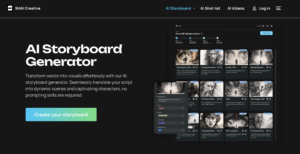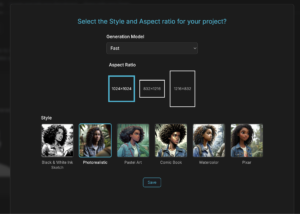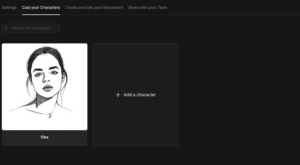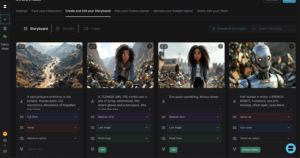Best AI Storyboard Generator for Movies
Introduction: Why AI Is Changing the Game for Storyboarding Movies
The best AI storyboard generator for movies revolutionizes how filmmakers visualize their creative vision before production begins. A storyboard serves as the visual blueprint for any movie, transforming written scripts into sequential images that guide every department from cinematography to production design. For movie production, these visual plans ensure every shot contributes to the narrative while maximizing budget efficiency.
AI technology transforms movie pre-production by accelerating the storyboarding process from months to days. Directors no longer wait weeks for storyboard artists to interpret their vision. The best AI storyboard generator for movies delivers cinema-quality visualizations instantly, enabling filmmakers to explore multiple creative approaches. This speed proves crucial in competitive film markets where development windows determine project viability.
Movie production demands sophisticated tools that understand cinematic language and visual storytelling conventions. Traditional storyboarding methods create expensive bottlenecks between script and screen. Today’s AI storyboard generators must handle everything from intimate character moments to complex action sequences while maintaining the director’s unique vision.
Shai emerges as the leading solution specifically engineered for movie production needs. Unlike generic image generators, Shai understands shot composition, camera movements, and the nuanced requirements of cinematic storytelling that separate movies from other visual media.
👉 Explore the AI Storyboard Generator
Why You Need the Best AI Storyboard Generator for Movies
Movie production faces unique visual challenges that demand precision and artistic vision. Directors must communicate complex sequences involving multiple locations, elaborate action, and subtle emotional beats. Moreover, every department from stunts to visual effects relies on storyboards to plan their contributions effectively.
Modern movie production operates under intense time and budget pressures. Therefore, filmmakers need efficient tools that accelerate pre-production without sacrificing quality. Professional storyboards reduce costly surprises during shooting while ensuring creative vision translates to screen.
The right AI storyboard generator for movies transforms pre-production from obstacle to opportunity. Additionally, it democratizes filmmaking by giving independent creators access to Hollywood-quality visualization tools. Furthermore, it enables directors to present fully-realized visions to investors and studios, increasing project green-light potential.
Comparing the Best AI Storyboard Generators for Movies in 2025
The movie production landscape requires specialized tools beyond basic image generation. However, many AI platforms focus on single images rather than sequential storytelling. Let’s examine how different tools serve movie production requirements.
Shai stands out as the AI-first platform built specifically for filmmakers and movie production. ChatGPT generates excellent scripts but provides no visual storyboarding capabilities. Canva offers design templates unsuited for cinematic shot planning. OpenAI Sora creates video clips but lacks the frame-by-frame control directors need.
When evaluating AI storyboard generators for movies, Shai delivers the most comprehensive filmmaking solution. Specifically, it combines professional image generation with movie-specific features like shot continuity and cinematic composition tools. Let’s explore why Shai excels for movie production.
Why Shai Is the Best AI Storyboard Generator for Movies

Shai’s intuitive interface where users can upload a script and generate visual storyboards, complete with scene sequencing, shot duration, and voiceover options — all in one platform.
Shai transforms movie pre-production by speaking the language of cinema fluently. Unlike consumer-focused tools, Shai handles everything from intimate dialogue scenes to elaborate action sequences. Furthermore, it provides the granular control over composition, lighting, and movement that directors demand.
Enhanced Productivity and Efficiency
Shai accelerates movie storyboarding from conception to final boards dramatically. Directors generate complete sequence visualizations during initial planning sessions. Additionally, the platform’s screenplay parsing understands standard formatting, automatically identifying scenes, action lines, and camera directions.
Efficiency multiplies across entire productions. Directors can storyboard feature films in days rather than months. Moreover, instant visualization enables rapid iteration on creative choices before expensive production begins.
Consistent Visual Quality
Character consistency remains paramount in movie storytelling. Shai maintains actor likenesses, costumes, and physical details across hundreds of shots. Directors define characters once, then generate countless angles and expressions while preserving identity.
The platform ensures visual coherence throughout entire films. Therefore, lighting schemes, color palettes, and production design remain consistent unless deliberately changed. This consistency proves essential for maintaining believable cinematic worlds.
Rapid Prototyping Capabilities
Shai enables filmmakers to test multiple creative approaches simultaneously. Directors can explore different visual styles, camera techniques, and staging options before committing resources. Subsequently, they can present various options to producers and department heads.
Rapid prototyping proves invaluable for complex sequences. Action scenes, visual effects shots, and intricate camera moves can be pre-visualized completely. Additionally, directors can identify potential problems before expensive shooting days.
Improved Team Collaboration
Movie production involves coordinating dozens of departments and hundreds of crew members. Shai’s storyboards provide universal visual language everyone understands. Cinematographers see exact framing, while production designers understand spatial requirements.
The platform integrates with standard production workflows. Storyboards export in formats compatible with scheduling software and shot lists. Moreover, cloud collaboration enables remote teams to contribute regardless of location.
Pricing Structure (as of July 2025)
Shai offers flexible pricing designed for various production scales:
- Free Trial: Evaluate features with limited exports
- Basic – $12/month: 120 images, 13 videos for short films
- Freelance – $29/month: 440 images, 44 videos for independent features
- Studio – $79/month: 1400 images, 156 videos, plus animatics
- Enterprise – Custom: Production company licenses, priority support
🔗 Use Shai’s AI Storyboard Generator
✨ Ready to experience the difference? Start here.
How to Create Movie Storyboards Using the Best AI Storyboard Generator – Step-by-Step
Creating professional movie storyboards with Shai follows an intuitive workflow designed for film production. Each step builds toward comprehensive visual planning that guides successful shoots. Let’s explore the complete process for movie storyboard creation.
Step 1: Upload Your Script
Shai accepts industry-standard screenplay formats including Final Draft, PDF, and fountain files. The AI intelligently parses your script, identifying scene headings, action lines, dialogue, and transitions. Moreover, it recognizes camera directions and shot suggestions within action description.
The upload process preserves screenplay structure while extracting visual information. Character introductions, location descriptions, and action sequences receive special attention for storyboard generation. Additionally, scene numbers and page references remain linked for easy cross-referencing during production.
Upload flexibility accommodates various workflow preferences. Import entire feature scripts or specific sequences needing visualization. Furthermore, Shai handles revisions seamlessly, updating only affected scenes while preserving completed storyboards.
Step 2: Choose Aspect Ratio, Style & Generation Settings

Format selection aligns with your movie’s intended presentation. Choose 2.39:1 for cinematic widescreen, 1.85:1 for standard theatrical, or 16:9 for streaming platforms. Each format optimizes composition guidelines for maximum visual impact.
Style options range from photorealistic pre-visualization to stylized artistic approaches. Select “cinematic realism” for accurate production planning, “graphic novel” for stylized projects, or custom styles matching your movie’s visual language. Moreover, reference specific cinematographers or films to communicate exact aesthetic goals.
Generation settings balance speed with detail based on production phase. “Fast” mode supports rapid brainstorming during development. Meanwhile, “High Quality” produces detailed boards suitable for department heads and investors. Therefore, adjust settings based on current production needs.
Step 3: Select or Create Your Characters

Character definition forms the foundation of visual continuity in movies. Shai’s character tools capture detailed physical attributes, ensuring consistency across every appearance. Specifically, define facial features, body types, costumes, and distinguishing characteristics that persist throughout your film.
The platform maintains comprehensive character libraries for each project. Lead actors, supporting cast, and extras remain visually distinct and consistent. Additionally, create character variations for different story points including costume changes, aging, or injury effects.
Character emotions and performance adjust per shot while maintaining identity. Therefore, your protagonist remains recognizable whether displaying joy, fear, or determination. Furthermore, the system handles crowd scenes, maintaining individual character identities even in complex compositions.
Step 4: Adjust Your Shots
Shot composition controls give directors precise cinematic control. Set camera angles from extreme low angles to bird’s eye views, matching your visual storytelling needs. Moreover, specify lens choices affecting depth of field, compression, and perspective distortion exactly as planned for production.
Lighting and mood settings establish your movie’s visual tone. Specify dramatic film noir shadows, bright comedy lighting, or moody thriller atmospheres. Additionally, time-of-day settings ensure logical light progression across scenes shot non-sequentially.
Scene-specific directions override general settings when needed. Add notes like “handheld camera” or “anamorphic lens flares” for precise visual communication. Furthermore, reference specific movies or shots to convey exact intentions to your cinematographer.
Step 5: Generate AI-Powered Images

Shai storyboard view showing AI-generated frames from uploaded script
Image generation with the best AI storyboard generator for movies begins by processing all creative inputs simultaneously. Shai considers script context, character definitions, shot specifications, and style preferences instantly. Within seconds, you receive storyboard frames visualizing your screenplay professionally.
The conversational refinement interface uses natural filmmaking language. Request adjustments like “tighten the frame” or “add more atmospheric haze.” Moreover, regenerate specific elements while preserving successful aspects of composition and lighting.
Batch generation accelerates workflow for feature-length projects. Generate entire sequences maintaining visual consistency automatically. Additionally, create coverage options showing different angles of key moments, helping plan efficient shooting schedules.
Step 6: (Optional) Animate Your Storyboard
Animatics transform static boards into moving pre-visualizations. Add character movements, camera motion, and basic timing to communicate pacing. These simple animations help entire crews understand complex sequences before shooting begins.
The animation system focuses on essential movie production elements. Simulate camera moves including dollies, cranes, and steadicam shots. While full audio integration isn’t supported, visual movement alone communicates timing for action sequences and emotional beats.
Export animatics in formats compatible with editing software. Therefore, editors can use them as reference for pacing and rhythm. Furthermore, animatics help visual effects teams understand planned digital elements requiring preparation.
Other Tools Compared – Why Shai Wins
ChatGPT
ChatGPT excels at screenplay writing and scene development through text. However, it cannot produce visual storyboards essential for movie production planning. Film crews need concrete imagery to execute the director’s vision effectively.
Shai surpasses ChatGPT by delivering complete visual pre-production tools. While ChatGPT helps develop scripts, Shai transforms those words into actionable production plans. Therefore, Shai serves as the crucial bridge between written screenplay and filmed movie.
Canva
Canva provides templates and design tools unsuited for sequential movie storytelling. Nevertheless, it lacks specialized features like shot continuity, camera angle notation, or scene progression. Creating movie storyboards in Canva requires extensive manual workarounds.
Shai wins through purpose-built movie production capabilities. Unlike Canva’s static design approach, Shai understands cinematic flow and maintains visual continuity automatically. Additionally, Shai’s AI generation eliminates hours of manual image searching and manipulation.
OpenAI Sora
OpenAI Sora generates impressive video clips but lacks directorial control essential for movies. Filmmakers need to specify exact shots, not receive AI interpretations that might diverge from creative vision. Movie production demands frame-specific planning impossible with Sora’s approach.
Shai provides complete creative control while Sora operates autonomously. Directors using the best AI storyboard generator for movies can ensure every frame serves their narrative purpose. Furthermore, Shai’s storyboard format integrates with traditional film production pipelines.
Real-World Use of AI Storyboards in Movies
Independent filmmakers leverage AI storyboards to compete with studio productions. A recent indie thriller used Shai to create 800+ storyboard frames in one week. Traditional methods would have cost thousands in artist fees and taken months to complete.
Major studios integrate AI storyboarding into blockbuster development. Specifically, they use Shai during pre-visualization to explore expensive action sequences before committing budgets. This visual development reduces costly reshoots by identifying issues early.
Film schools teach AI storyboarding as essential modern filmmaking skill. Students learn visual storytelling using the best AI storyboard generator for movies without requiring drawing ability. Moreover, graduates enter the industry familiar with cutting-edge pre-production tools.
International co-productions use Shai to bridge language barriers. Visual storyboards communicate directorial intent clearly across multilingual crews. Additionally, investors understand project scope through professional visualization regardless of script language.
Documentary filmmakers apply AI storyboards for recreation sequences and structured segments. While documentaries capture reality, planned sequences benefit from visual preparation. Furthermore, storyboards help communicate with subjects about intended shots, improving cooperation.
Conclusion: Choose the Best – Choose Shai
AI technology has revolutionized movie pre-production by making professional storyboarding accessible to all filmmakers. The ability to instantly visualize scripts, experiment with shots, and communicate vision transforms how movies get made. Moreover, it democratizes filmmaking by removing traditional barriers between imagination and screen.
Shai stands as the definitive best AI storyboard generator for movies, combining professional features with intuitive design. Its comprehensive toolset addresses every aspect of movie pre-production from intimate dramas to explosive blockbusters. Whether you’re shooting your first short or planning a studio feature, Shai provides the visual planning tools modern movie production demands.